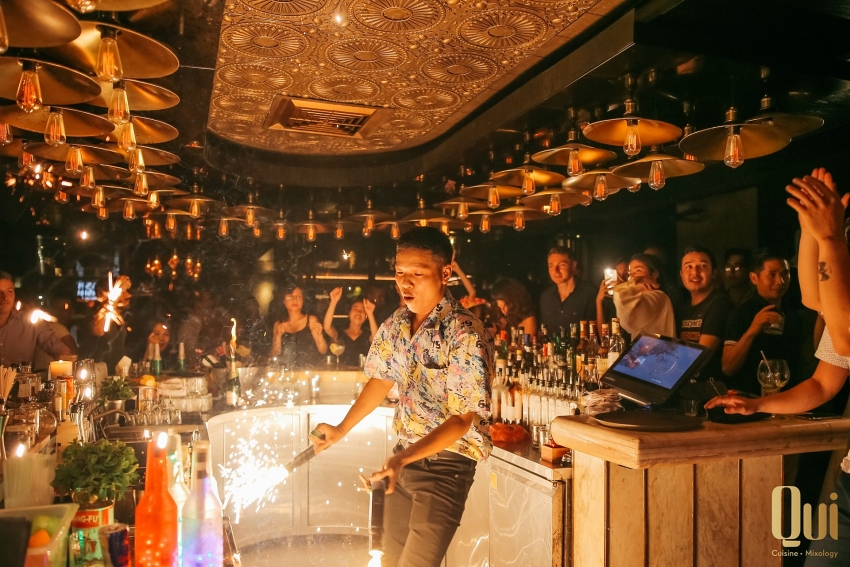Vietnam keeps non-essential businesses closed to contain COVID-19
In the new directive, the prime minister urged non-essential businesses such as bars, karaoke or massage parlours, fitness centres, spas and beauty clinics to stay closed.
Although it disrupts these businesses, this approach – which aims to maximise efforts against the disease while attempting to avoid all but the necessary dislocations – is the right path.
He also ordered relevant ministries, agencies, and People's Committees of localities to strictly maintain a variety of measures to contain the virus.
 |
| Bars, karaoke parlors, and fitness centres stay closed for now (Photo: Qui cuisine and mixology) |
Social gatherings, sports events, or festivals outside workplaces, schools, and hospitals are still banned.
A minimum distance of one metre between people in public places should be maintained – down one metre from the previous directive on nationwide social distancing.
Residents should also wear face masks, along with washing their hands vigorously with soap and water.
At school, it is highly recommended to reduce the number of students in a classroom to increase distance between them or arrange different class or lunchtimes while disinfecting classrooms periodically.
Online learning is also encouraged, along with other preventive measures for students.
Restrictions on movement are being gradually eased as Vietnam tries to restart the economy without inviting another wave of infections.
Factories and production facilities may remain open but must impose strict hygienic measures and organisational rules.
Management staff should alternate between working at the office and from home, with the minimum distance closely monitored.
Health authorities, on the other hand, urged vigilance, warning that new clusters could still emerge at any time.
Furthermore, important events for political, economic or social purposes must be authorised by local authorities – with medical protection such as face masks, hand sanitiser or appropriate distancing. No parties or celebrations are allowed.
Wholesale and retail services can also resume operations. Besides, hotels, restaurants, sports areas, relics and sights are permitted to open but they must satisfy all public healthcare requirements such as protective clothing for staff or monitoring visitors' body temperature.
Firms are also required to make flexible work arrangements for employees to tie in with the government strategies.
PM Phuc also allowed the resumption of inter-provincial public transportation. However, passengers and drivers must wear masks and carry out other anti-pandemic solutions.
“Low-risk" localities should advise their residents to stay at home and suspend all social gatherings of more than 30 people in public places.
Hanoi, Ho Chi Minh City, Bac Ninh, and Ha Giang in northern Vietnam are classified at a higher risk category. The rest are determined as exposed to a "low risk" of infection, according to Vnexpress.
Officials echoed the call for physical distancing measures and frequent handwashing to remain in place after the lockdown has been lifted.
On the other hand, Vietnam continues restricting the entry of foreign nationals and those allowed to enter Vietnam must be quarantined for 14 days.
According to a group of Harvard disease experts, some form of intermittent social distancing may need to be in place until 2022. That is because once the initial wave of COVID-19 infections has passed, further outbreaks could occur. This aligns with warnings by experts at the World Economic Forum, who cautioned that if lockdown restrictions are lifted at the same time, instead of in co-ordinated phases, a surge in new cases could overwhelm healthcare systems.
What the stars mean:
★ Poor ★ ★ Promising ★★★ Good ★★★★ Very good ★★★★★ Exceptional
Related Contents
Latest News
More News
- Driving double-digit growth through green and circular transformation in Vietnam (December 17, 2025 | 09:00)
- Vietnam bucking trend in the global M&A landscape (December 16, 2025 | 14:20)
- Vietnam’s green transition demands collective financial action (December 15, 2025 | 12:00)
- VIR workshop highlights capital and policy for sustainable development (December 15, 2025 | 11:00)
- National Assembly approves pilot mechanisms to accelerate major projects in Hanoi (December 12, 2025 | 11:29)
- Vietnam eases policy approval requirements, simplifies foreign and outbound investments (December 11, 2025 | 17:53)
- Unpacking new momentum in Vietnam’s M&A market (December 10, 2025 | 09:59)
- Forum honours outstanding M&A deals, strategies, and advisory firms (December 09, 2025 | 18:22)
- Vietnam enters defining phase of M&A growth (December 09, 2025 | 17:00)
- Vietnam’s M&A market opens new opportunities amid strong economic momentum (December 09, 2025 | 15:00)

 Tag:
Tag:




























 Mobile Version
Mobile Version